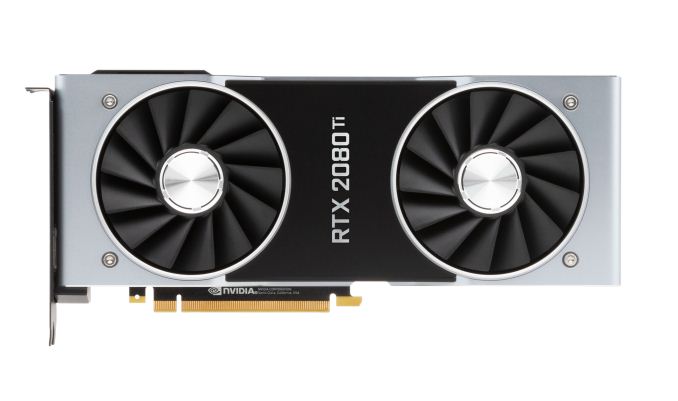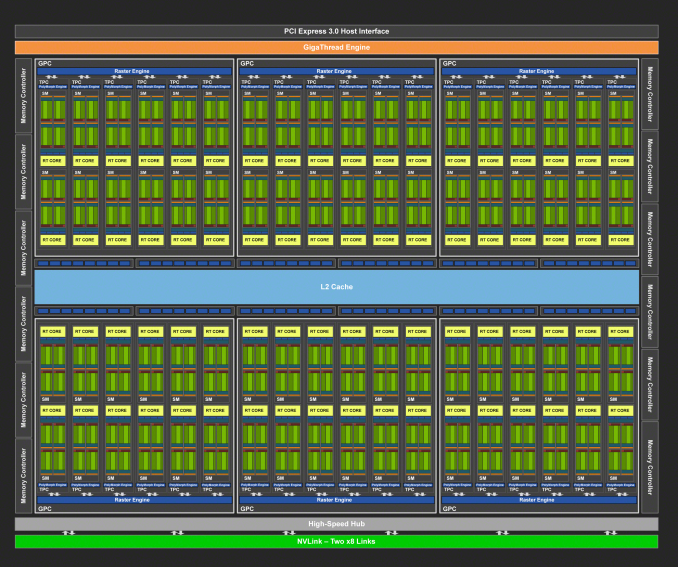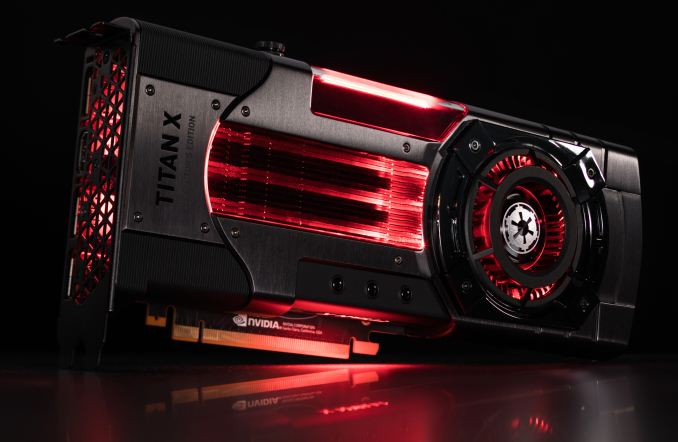The NVIDIA GeForce RTX 2080 Ti & RTX 2080 Founders Edition Review: Foundations For A Ray Traced Future
by Nate Oh on September 19, 2018 5:15 PM EST- Posted in
- GPUs
- Raytrace
- GeForce
- NVIDIA
- DirectX Raytracing
- Turing
- GeForce RTX

While it was roughly 2 years from Maxwell 2 to Pascal, the journey to Turing has felt much longer despite a similar 2 year gap. There’s some truth to the feeling: looking at the past couple years, there’s been basically every other possible development in the GPU space except next-generation gaming video cards, like Intel’s planned return to discrete graphics, NVIDIA’s Volta, and cryptomining-specific cards. Finally, at Gamescom 2018, NVIDIA announced the GeForce RTX 20 series, built on TSMC’s 12nm “FFN” process and powered by the Turing GPU architecture. Launching today with full general availability is just the GeForce RTX 2080, as the GeForce RTX 2080 Ti was delayed a week to the 27th, while the GeForce RTX 2070 is due in October. So up for review today is the GeForce RTX 2080 Ti and GeForce RTX 2080.
But a standard new generation of gaming GPUs this is not. The “GeForce RTX” brand, ousting the long-lived “GeForce GTX” moniker in favor of their announced “RTX technology” for real time ray tracing, aptly underlines NVIDIA’s new vision for the video card future. Like we saw last Friday, Turing and the GeForce RTX 20 series are designed around a set of specialized low-level hardware features and an intertwined ecosystem of supporting software currently in development. The central goal is a long-held dream of computer graphics researchers and engineers alike – real time ray tracing – and NVIDIA is aiming to bring that to gamers with their new cards, and willing to break some traditions on the way.
| NVIDIA GeForce Specification Comparison | ||||||
| RTX 2080 Ti | RTX 2080 | RTX 2070 | GTX 1080 | |||
| CUDA Cores | 4352 | 2944 | 2304 | 2560 | ||
| Core Clock | 1350MHz | 1515MHz | 1410MHz | 1607MHz | ||
| Boost Clock | 1545MHz FE: 1635MHz |
1710MHz FE: 1800MHz |
1620MHz FE: 1710MHz |
1733MHz | ||
| Memory Clock | 14Gbps GDDR6 | 14Gbps GDDR6 | 14Gbps GDDR6 | 10Gbps GDDR5X | ||
| Memory Bus Width | 352-bit | 256-bit | 256-bit | 256-bit | ||
| VRAM | 11GB | 8GB | 8GB | 8GB | ||
| Single Precision Perf. | 13.4 TFLOPs | 10.1 TFLOPs | 7.5 TFLOPs | 8.9 TFLOPs | ||
| Tensor Perf. (INT4) | 430TOPs | 322TOPs | 238TOPs | N/A | ||
| Ray Perf. | 10 GRays/s | 8 GRays/s | 6 GRays/s | N/A | ||
| "RTX-OPS" | 78T | 60T | 45T | N/A | ||
| TDP | 250W FE: 260W |
215W FE: 225W |
175W FE: 185W |
180W | ||
| GPU | TU102 | TU104 | TU106 | GP104 | ||
| Transistor Count | 18.6B | 13.6B | 10.8B | 7.2B | ||
| Architecture | Turing | Turing | Turing | Pascal | ||
| Manufacturing Process | TSMC 12nm "FFN" | TSMC 12nm "FFN" | TSMC 12nm "FFN" | TSMC 16nm | ||
| Launch Date | 09/27/2018 | 09/20/2018 | 10/2018 | 05/27/2016 | ||
| Launch Price | MSRP: $999 Founders $1199 |
MSRP: $699 Founders $799 |
MSRP: $499 Founders $599 |
MSRP: $599 Founders $699 |
||
As we discussed at the announcement, one of the major breaks is that NVIDIA is introducing GeForce RTX as the full upper tier stack with x80 Ti/x80/x70 stack, where it has previously tended towards the x80/x70 products first, and the x80 Ti as a mid-cycle refresh or competitive response. More intriguingly, each GeForce card has their own distinct GPU (TU102, TU104, and TU106), with direct Quadro and now Tesla variants of TU102 and TU104. While we covered the Turing architecture in the preceding article, the takeaway is that each chip is proportionally cut-down, including the specialized RT Cores and Tensor Cores; with clockspeeds roughly the same as Pascal, architectural changes and efficiency enhancements will be largely responsible for performance gains, along with the greater bandwidth of 14Gbps GDDR6.
And as far as we know, Turing technically did not trickle down from a bigger compute chip a la GP100, though at the architectural level it is strikingly similar to Volta/GV100. Die size brings more color to the story, because with TU106 at 454mm2, the smallest of the bunch is frankly humungous for a FinFET die nominally dedicated for a x70 GeForce product, and comparable in size to the 471mm2 GP102 inside the GTX 1080 Ti and Pascal Titans. Even excluding the cost and size of enabled RT Cores and Tensor Cores, a slab of FinFET silicon that large is unlikely to be packaged and priced like the popular $330 GTX 970 and still provide the margins NVIDIA is pursuing.
These observations are not so much to be pedantic, but more so to sketch out GeForce Turing’s positioning in relation to Pascal. Having separate GPUs for each model is the most expensive approach in terms of research and development, testing, validation, extra needed fab tooling/capacity – the list goes on. And it raises interesting questions on the matter of binning, yields, and salvage parts. Though NVIDIA certainly has the spare funds to go this route, there’s surely a better explanation than Turing being primarily designed for a premium-priced consumer product that cannot command the margins of professional parts. These all point to the known Turing GPUs as oriented for lower-volume, and NVIDIA’s financial quarterly reports indicate that GeForce product volume is a significant factor, not just ASP.
And on that note, the ‘reference’ Founders Edition models are no longer reference; the GeForce RTX 2080 Ti, 2080, and 2070 Founders Editions feature 90MHz factory overclocks and 10W higher TDP, and NVIDIA does not plan to productize a reference card themselves. But arguably the biggest change is the move from blower-style coolers with a radial fan to an open air cooler with dual axial fans. The switch in design improves cooling capacity and lowers noise, but with the drawback that the card can no longer guarantee that it can cool itself. Because the open air design re-circulates the hot air back into the chassis, it is ultimately up to the chassis to properly exhaust the heat. In contrast, a blower pushes all the hot air through the back of the card and directly out of the case, regardless of the chassis airflow or case fans.
All-in-all, NVIDIA is keeping the Founders Edition premium, which is now $200 over the baseline ‘reference.’ Though AIB partner cards are also launching today, in practice the Founders Edition pricing is effectively the retail price until the launch rush has subsided.
The GeForce RTX 20 Series Competition: The GeForce GTX 10 Series
In the end, the preceding GeForce GTX 10 series ended up occupying an odd spot in the competitive landscape. After its arrival in mid-2016, only the lower end of the stack had direct competition, due to AMD’s solely mainstream/entry Polaris-based Radeon RX 400 series. AMD’s RX 500 series refresh in April 2017 didn’t fundamentally change that, and it was only until August 2017 that the higher-end Pascal parts had direct competition with their generational equal in RX Vega. But by that time, the GTX 1080 Ti (not to mention the Pascal Titans) was unchallenged. And all the while, an Ethereum-led resurgence of mining cryptocurrency on video cards was wreaking havoc on GPU pricing and inventory, first on Polaris products, then general mainstream parts, and finally affecting any and all GPUs.
Not that NVIDIA sat on their laurels with Vega, releasing the GTX 1070 Ti anyhow. But what was constant was how the pricing models evolved with the Founders Editions schema, the $1200 Titan X (Pascal), and then $700 GTX 1080 Ti and $1200 Titan Xp. Even the $3000 Titan V maintained gaming cred despite diverging greatly from previous Titan cards as firmly on the professional side of prosumer, basically allowing the product to capture both prosumers and price-no-object enthusiasts. Ultimately, these instances coincided with the rampant cryptomining price inflation and was mostly subsumed by it.
So the higher end of gaming video cards has been Pascal competing with itself and moving up the price brackets. For Turing, the GTX 1080 Ti has become the closest competitor. RX Vega performance hasn’t fundamentally changed, and the fallout appears to have snuffed out any Vega 10 parts, as well as Vega 14nm+ (i.e. 12nm) refreshes. As a competitive response, AMD doesn’t have many cards up their sleeves except the ones already played – game bundles (such as the current “Raise the Game” promotion), FreeSync/FreeSync 2, other hardware (CPU, APU, motherboard) bundles. Other than that, there’s a DXR driver in the works and a machine learning 7nm Vega on the horizon, but not much else is known, such as mobile discrete Vega. For AMD graphics cards on shelves right now, RX Vega is still hampered by high prices and low inventory/selection, remnants of cryptomining.
For the GeForce RTX 2080 Ti and 2080, NVIDIA would like to sell you the RTX cards as your next upgrade regardless of what card you may have now, essentially because no other card can do what Turing’s features enable: real time raytracing effects ((and applied deep learning) in games. And because real time ray tracing offers graphical realism beyond what rasterization can muster, it’s not comparable to an older but still performant card. Unfortunately, none of those games have support for Turing’s features today, and may not for some time. Of course, NVIDIA maintains that the cards will provide expected top-tier performance in traditional gaming. Either way, while Founders Editions are fixed at their premium MSRP, custom cards are unsurprisingly listed at those same Founders Edition price points or higher.
| Fall 2018 GPU Pricing Comparison | |||||
| AMD | Price | NVIDIA | |||
| $1199 | GeForce RTX 2080 Ti | ||||
| $799 | GeForce RTX 2080 | ||||
| $709 | GeForce GTX 1080 Ti | ||||
| Radeon RX Vega 64 | $569 | ||||
| Radeon RX Vega 56 | $489 | GeForce GTX 1080 | |||
| $449 | GeForce GTX 1070 Ti | ||||
| $399 | GeForce GTX 1070 | ||||
| Radeon RX 580 (8GB) | $269/$279 | GeForce GTX 1060 6GB (1280 cores) |
|||













337 Comments
View All Comments
milkod2001 - Thursday, September 20, 2018 - link
NV is messing with us. Even with no competition from AMD those price hikes at such low performance gains are laughable. This generation of new GPU seems like just a stop gap before NV will have something more serious to show next year.willis936 - Thursday, September 20, 2018 - link
No they seem like they will be exactly the same as the 1000 series: they are what they are, you pay what they ask, and they will be the only decent option they offer for the next two years.Maybe if Radeon ever gets their shit together the landscape might look different in 2-3 years but trust me: for now, expect more of the same.
milkod2001 - Thursday, September 20, 2018 - link
Yeah we are pretty much getting into Intel vs AMD scenario when Intel dominates for a years and bring customers overpriced products with very slow performance upgrades. There is a hope AMD will at least try to do something about it.yhselp - Thursday, September 20, 2018 - link
The temperature and noise results are shocking. The results are much closer to what you'd expect from a blower, rather than an open-air cooler. Previous gen OEM solutions do much better than this. What's the reason for this?milkod2001 - Thursday, September 20, 2018 - link
Chips are much bigger than previous gen.iwod - Thursday, September 20, 2018 - link
I think we need DLSS and Hybrid Ray Tracing to judge whether it is worth it. At the moment, we could have the nearly double the performance of 1080Ti if we simply have a 7xxmm2 Die of it.I think the idea Nvidia had is that we have reached the plateau of Graphic Gaming. Imagine what you could do with a 7nm 7xxm2 Die of 2080Ti? Move the 4K Ultra High Quality frame rate from ~60 to 100? That is in 2019, in 2022 3nm, double that frame rate from 100 to 200?
The industry as a whole needs to figure out how to extract even more Graphics Quality with less transistors, simpler software while at the same time makes 3D design modelling easier. The graphics assets from gaming are now worth 100s to millions. Just the asset, not engine programming, network, 3D interaction etc, nothing to do with code. Just the Graphics. And Hybrid Ray tracing is an attempt to bring more quality graphics without the ever increasing cost of Engine and graphics designer simulating those effect.
What is interesting is that we will have 8 Core 5Ghz CPU and 7nm GPU next year.
Chawitsch - Thursday, September 20, 2018 - link
Given how much die space is dedicated to the new features software support will definitely be the key for these cards' success. Otherwise their price is just too high for what they offer today. Buying these cards now is somewhat of a gamble, but nVidia does have excellent relations with developers however, so support should come. As someone who would like to have a capable GPU for 100+ FPS gaming at 1440p, especially one that is future proof, I would much rather take my chances with these new cards.To me the question is this, would it really be worth focusing even more on 4k gaming, when it is a fairly niche market segment still due to monitor prices (especially ones with low latency for gaming). Arguably these high end cards are niche too, but when we can already have 4k@60 FPS, with maxed graphics settings, other considerations become more important. At any given resolution and feature level pure performance becomes meaningless after a certain point, at least for gaming. Arguing that reaching 100 FPS at 4k definitely has merit in my opinion, but by the time really good 4k monitors take over we'll get there, even with the path nVidia took.
Regarding graphics quality and transistor count, ray tracing should be a win here, if not now in the future certainly. There are diminishing returns with rasterization as you approach more realistic scenes and ray tracing makes you jump through less hoops to if you want to create a correct looking scene.
MadManMark - Thursday, September 20, 2018 - link
"I think the idea Nvidia had is that we have reached the plateau of Graphic Gaming. Imagine what you could do with a 7nm 7xxm2 Die of 2080Ti?"Yes, but that is probably why they stuck with 12nmFF actually. Note the die size, plus each card has its own GPU, rather than binned selection from the same GPU (kudos to Nate for also ruminating briefly on this in text). This means maximizing yiled is particularly important, and so begs for a mature, efficient process. TSMC achieved great things with their current 7nm process, no knock on it, but it is still UV-based, it's been long documented that there are yield challengels with that. IMO Nvidia will wait to hitch their wagons to TSMC's next process (expected next year), EUV-based 7nm+, which is expected to mitigate a lot of these yield concerns.
In other words it will be very interesting to see what the 2180 Ti looks like next year -- yes, I built a lot of assumptions into that sentence ;)
eddman - Thursday, September 20, 2018 - link
Come on, the naming is already set; 1080, 2080, 3080. What the hell is a "2180"?P.S. OCD
Lolimaster - Saturday, September 22, 2018 - link
That works if you expect graphics to be stagnant, tons of mini effects and polygon count will chunk a current 1080ti to 10fps in 2021.